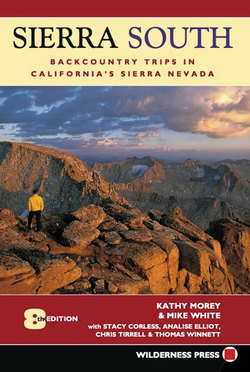Читать книгу Sierra South - Mike White - Страница 18
На сайте Литреса книга снята с продажи.
ОглавлениеKAISER PASS ROAD TRIPS
Potter Pass Trailhead 7855´; 11S 309230 4126844
Information and Permits: This trailhead is in Sierra National Forest: 1600 Tollhouse Road, Clovis, CA 93611, 559-297-0706, www.fs.fed.us/r5/sierra/. Permits are required for overnight stays, and quotas apply; reserved permits and on-demand permits are available.
Driving Directions: From Clovis (near Fresno), take State Hwy. 168 northeast for 42 winding, slow miles to its end at a T junction on the east shore of Huntington Lake at the community of Lakeshore. Turn right, away from Lakeshore, on Kaiser Pass Road, and go 2.7 more miles to a junction with a dirt road on the left (north). Turn left and go 0.2 mile to its end at the Potter Pass Trailhead for Kaiser Wilderness.
12 George Lake
Trip Data: 11S 307566 4129484; 9.4 miles; 2/1 days
Topos: Kaiser Peak
Highlights: In the heart of the Sierra National Forest, little Kaiser Wilderness boasts 35 square miles of pristine forests, emerald lakes, and rugged alpine terrain. Despite its immediate proximity to Huntington Lake, Kaiser Wilderness lures relatively few hikers compared to neighboring John Muir and Ansel Adams wildernesses. This short trip samples its solitude and ample swimming and fishing opportunities.
DAY 1 (Potter Pass Trailhead to George Lake, 4.7 miles): From the Potter Pass Trailhead, the trail briefly parallels Potter Creek before steeply climbing its west fork. The path bears east as it ascends southeast-facing slopes that offer views southeast toward the highest peaks of neighboring Dinkey Lakes Wilderness—10,000-plus-foot Three Sisters (seen as a series of rounded granite studs) and barren, serrated, 10,302-foot Dogtooth Peak. The strenuous climb culminates 2.5 miles from the trailhead at Potter Pass (8970´), where your trail converges with the California Riding and Hiking Trail, coming up from a trailhead farther east on Kaiser Pass Road.
VIEWS FROM POTTER PASS
Epic views await at the pass! In the north, Balloon Dome stands alone as a prominent granite knob jutting from the enormously visible San Joaquin River valley. Farther north, the Minarets of the Ritter Range are easily identified as the dark, jagged peaks, remnants of volcanoes that erupted some 100 million years ago. East-southeast, South Fork San Joaquin River drains the mountains of northern Kings Canyon National Park, while Middle Fork San Joaquin River curves north below distant Mammoth Crest, which separates the river from the Mammoth Lakes basin.
From the junction at Potter Pass, the merged trails continue ahead (north) as one and descend 0.7 mile to Round Meadow and a junction with the George Lake Trail (8650´). Turn left (generally west) and skirt the broad meadow, which offers wildflowers in summer and fall colors in autumn, thanks to aspens fringing it.
The trail briefly joins Lower Twin Lake’s outlet before reaching that lake’s shallow, sedge-lined shores. Lower Twin Lake (8610´) is a snow-fed lake set in 800-foot granite cliffs that rise toward a rugged 9559-foot peak to the south. The lake has a gentle, mature feel, with large trees and smooth, lichen-covered cliffs. Small brook trout are plentiful. Although there are a few campsites, better ones lie ahead at Upper Twin Lake and George Lake.
Continuing to Upper Twin Lake, the trail skirts a diminutive seasonal pond and traverses an easy half mile to exquisite Upper Twin Lake’s east shore (8601´; yes, Upper Twin Lake is lower than Lower Twin Lake). The lake’s sparkling blue waters are interrupted by smooth granite slab islands that host surprisingly large Jeffrey pine, red fir, and lodgepole pine. But that’s not the lake’s only peculiar feature: It has no outflow. A few steps north, a conspicuous boulder masks a rocky pit that indicates water moving underground from the lake toward Kaiser Creek.
As the path leads 100 feet north around the lake, it meets a marked junction with a trail branching right (8650´) and another 0.1 mile farther (8680´). Take the left fork at each junction, first north and then west, as the trail climbs above the Twin Lakes’ northwestern basin, passing towering juniper pine among sugary, quartz-white granite.
Curve southwest as the trail weaves under massive western white pine to and from the creek that connects George Lake to Upper Twin Lake. The tread eventually crosses the creek and in 70 feet reaches the first of several campsites along George Lake (9100´; 11S 307566 4129484). The most scenic sites are located along the western shore between the inlet and the large granite wall that rims the northwest shore.
A cross-country route from George Lake climbs past College Lake to meet the Kaiser Loop Trail.
High above George Lake on the Kaiser Loop Trail, look east for views deep into the headwaters of the San Joaquin drainage.
SIDE TRIP: CROSS-COUNTRY DAYHIKE TO COLLEGE LAKE AND THE KAISER LOOP TRAIL
From George Lake, an adventurous cross-country route leads to College Lake and, with a bit of scrambling suitable for a daypack but not a full backpack, to a saddle where your route can join the Kaiser Loop Trail (Trip 13) to Kaiser Peak. Follow a use trail counterclockwise around George Lake and ascend approximately west-northwest from the scenic campsites mentioned in the main text. Loosely follow the creek connecting College and George lakes. From College Lake (9520´; 11S 307025 412955), bear south toward a visible, rocky saddle. The last 150 feet of the ascent is a loose, rocky scramble to the saddle, where this route joins the Kaiser Loop Trail (9770´; 306958 4128973). If you are venturing for a grander tour of the wilderness, turn right (north and then west) at this unmarked and unofficial junction to go 1 mile farther to 10,310-foot Kaiser Peak.
DAY 2 (George Lake to Potter Pass Trailhead, 4.7 miles): Retrace your steps to the trailhead.
